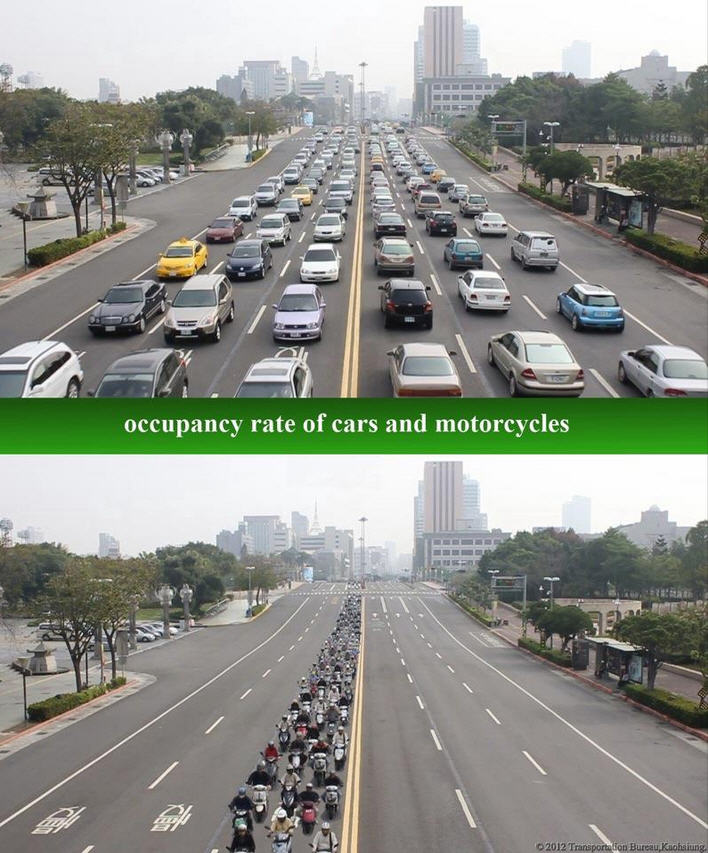

Thanks to Kent Wang, Director General of the Transportation Bureau of the city of Kaohsiung for sharing this striking photograph with us this morning. When you look at it, what thoughts does it inspire?
That's a great picture and a ringing reminder for transport planners and policy makers in all those cities, especially in the Asia region, where motorized two wheelers (M2W) play such a massive de facto role in providing the kinds of mobility that citizens prefer. (After all nobody is standing there with a gun at their back and making them buy and use these systems; they chose to scoot on the grounds of convenience, speed, time, versatility and cost. And sometimes, as with the car, for social status.) Now that is making it a pretty challenging competitor for conventional mass transit. Okay, so why is it a good idea to have a M2W strategy for a city like Kaohsiung? All you have to do is sit down for a couple of minutes and observe what happens on the city's streets. And then your eye will tell you what the statistics also bear out. Namely that Kaohsiung is a city in which private transport accounts for close to 80% of the modal split, more than 60% of which accounted for my trips on motorcycles and scooters, and less than 17% cars. (And in that they are, of course, far from alone.)
Okay, so why is it a good idea to have a M2W strategy for a city like Kaohsiung? All you have to do is sit down for a couple of minutes and observe what happens on the city's streets. And then your eye will tell you what the statistics also bear out. Namely that Kaohsiung is a city in which private transport accounts for close to 80% of the modal split, more than 60% of which accounted for my trips on motorcycles and scooters, and less than 17% cars. (And in that they are, of course, far from alone.)
What this suggests to us is that since the fact is that, warts and all, the major de facto means of transport in the city is the M2W, then should it not be the main focus of transport policy? On the grounds that the most pragmatic and powerful strategy, especially when you are looking for affordable near-term results that move the broader direction of sustainable transport and a sustainable city, is to work with what you have. And Kaohsiung has all those motorcycles and scooters already on the road (QED).
Of course once you start to look at them closely from a policy perspective it is immediately evident that there are lots of things in the present configuration that need to be rationalised and improved. Among the most flagrant examples that jump out at the observer are of course safety for drivers, passengers and pedestrians, pollution and air quality, undisciplined driver behaviour, condition of the vehicles, repair and maintenance, chaotic parking, conflicts with bicycles, policing and enforcement, dangers at intersections and in particular left hand turns, and the long list goes on. But as we like to say, these are not problems, they are the problematique, and there is no doubt that wise government policy can do a huge amount to improve life for all involved.
It would be a magnificent contribution if the city of Kaohsiung would set out to make itself the world's safest, most healthy and most efficient system for M2W – and to share their results openly with the world And if we look one last time at the picture sent to us by the transport planning unit of the city, we can see there is plenty of room there to get it right.
# # # Kent Wang, is Director General of the Transportation Bureau of the city of Kaohsiung in Taiwan. He has over the last five years lead an important program to green the city's transportation system, on which you can find a summary English.language report here.
Kent Wang, is Director General of the Transportation Bureau of the city of Kaohsiung in Taiwan. He has over the last five years lead an important program to green the city's transportation system, on which you can find a summary English.language report here.
# # #
Monday, February 27, 2012
Message from Kaohsiung
Subscribe to:
Post Comments (Atom)



Two-stroke oil-burning Vespa engines. Woot?
ReplyDeletePart of the problematique, definitely. But our job is not to give up, eh?
ReplyDeleteKent and Eric, The image is a marvellous demonstration of the space efficiency of the humble scooter. Really inspiring, thanks.
ReplyDeleteRiding a scooter around Kaohsiung is quick, exceptionally convenient and very low cost for the driver, and I imagine for the city, although the costs in terms of accidents and injury may be high.
Despite safety, and your other well observed problems, I find riding around the city quite pleasant, it feels safer than other Taiwanese cities, mostly due to the sheer number of scooters, but also the semi-segregated lanes. In fact I also don't find riding a bicycle along with the scooters at all bad, as long as I ride quickly.
I guess the thoughts the picture inspires are that if it were possible to make riding powered two wheelers safer for the riders, as well as pedestrians and cyclists, could we not therefore expect to see some shift towards walking and two wheelers?
If so, then in Kaohsiung, and many other cities around the developing world, would the extra space efficiency gained not allow for improvements to pedestrian and cycling facilities?